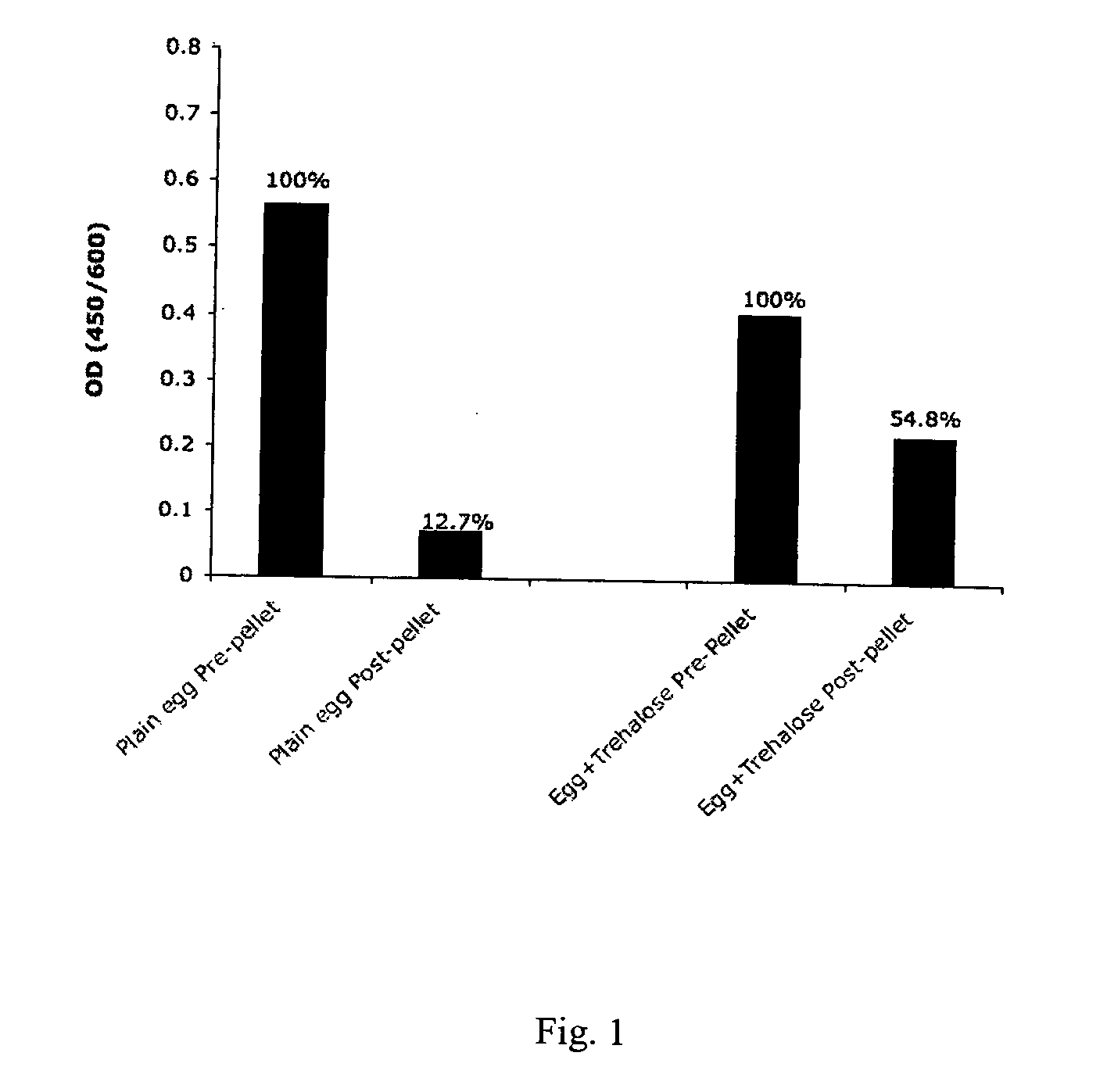Methods for heat-stabilizing proteins with specific binding activities
a technology of specific binding activity and protein, which is applied in the direction of antibody medical ingredients, peptides/protein ingredients, peptides, etc., can solve the problems of limited use of such proteins and limited use of these antibodies in feeding mash
- Summary
- Abstract
- Description
- Claims
- Application Information
AI Technical Summary
Benefits of technology
Problems solved by technology
Method used
Image
Examples
example 1
Trehalose and a combination of sucrose and starch reduced the loss of antigen binding activity of PLA2 antibody
Materials and Methods
[0025] Egg anti-PLA2 antibody was produced by injecting three hundred 20-week-old laying hens with antigen PLA2 (Sigma, St. Louis, Mo.). Antigen was prepared by emulsifying equal volume of antigen solution (200 μg / ml) with Freund's adjuvant (Sigma). Each hen was injected intramuscularly with a total of 1 ml emulsified PLA2 (each of the two thighs and two breasts was injected with one 0.25 ml inoculum). Freund's complete adjuvant was used only in the first inoculation and Freund's incomplete adjuvant was used in the later injections. Second inoculation was one week after the first inoculation and the subsequent inoculation was two months apart.
[0026] Birds were checked daily for morbidity and mortality. Egg production was also recorded daily. Eggs from hens inoculated with PLA2 were collected starting at day 21 after the first inoculation. Eggs were ...
example 2
Animal feed pellets containing trehalose protected PLA2 antibodies were effective to promote animal growth
Materials and Methods
[0029] A total of 954 broiler chickens were randomly assigned to either a control group or a PLA2 antibody group and their body weights were recorded. In the control group, birds received standard commercial pellet feed. In the PLA2 antibody group, the pellet feed was formulated to contain 0.125% (by weight) sugar-associated PLA2 antibody egg powder and produced with trehalose as described in Example 1. Birds were kept on the above diets for 4 weeks and their body weights were recorded at the end of the 4 weeks.
Results
[0030] As expected from random assignment, the average body weights of the control and PLA2 groups were the same at the beginning of the trial (data not shown). At the end of the trial, the average body weight of PLA2 antibody group was higher than that of the control group (p2 antibody with trehalose, chicken feed containing the antibody...
PUM
| Property | Measurement | Unit |
|---|---|---|
| binding-activity-destroying temperature | aaaaa | aaaaa |
| temperature | aaaaa | aaaaa |
| temperature | aaaaa | aaaaa |
Abstract
Description
Claims
Application Information
 Login to View More
Login to View More - R&D
- Intellectual Property
- Life Sciences
- Materials
- Tech Scout
- Unparalleled Data Quality
- Higher Quality Content
- 60% Fewer Hallucinations
Browse by: Latest US Patents, China's latest patents, Technical Efficacy Thesaurus, Application Domain, Technology Topic, Popular Technical Reports.
© 2025 PatSnap. All rights reserved.Legal|Privacy policy|Modern Slavery Act Transparency Statement|Sitemap|About US| Contact US: help@patsnap.com

